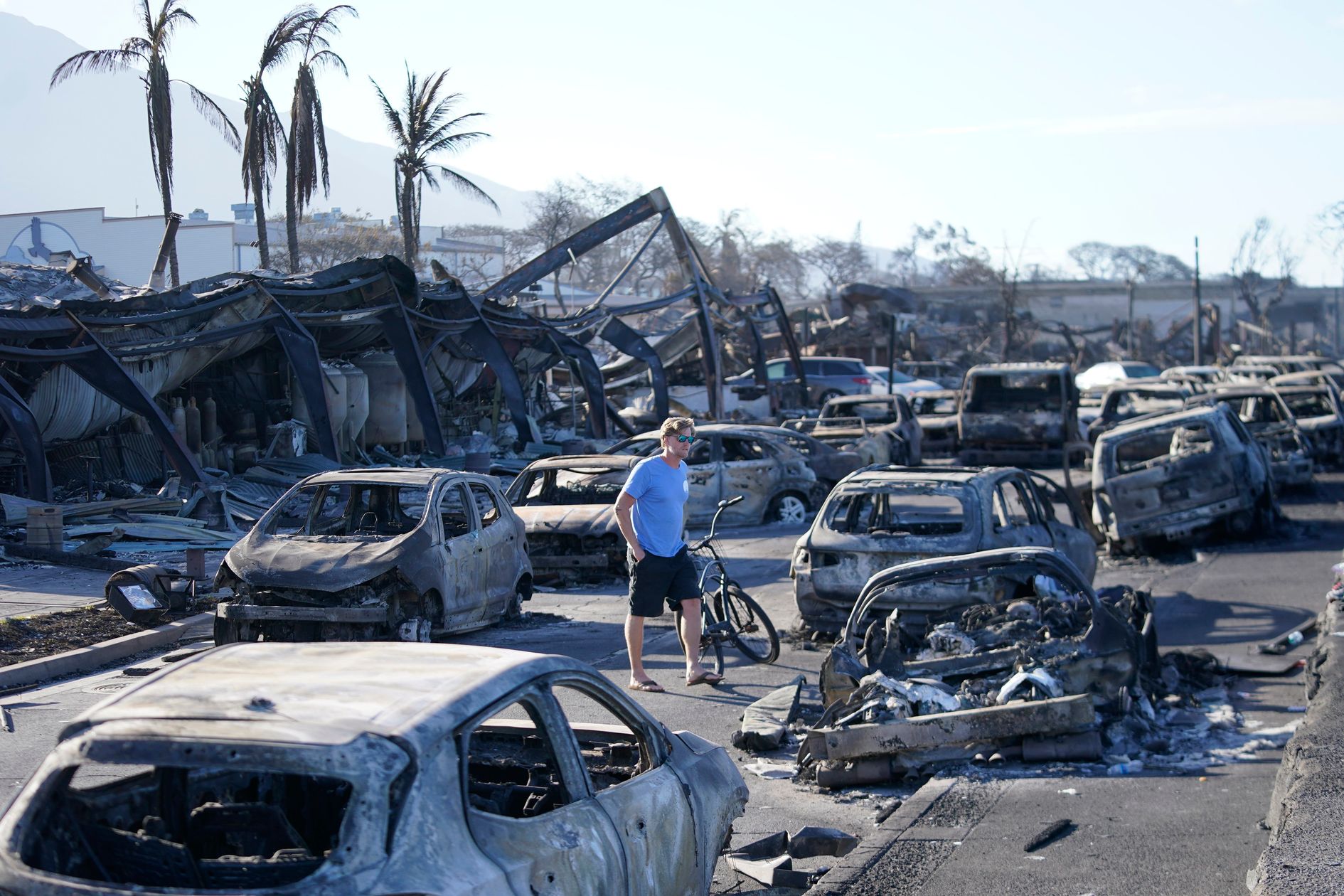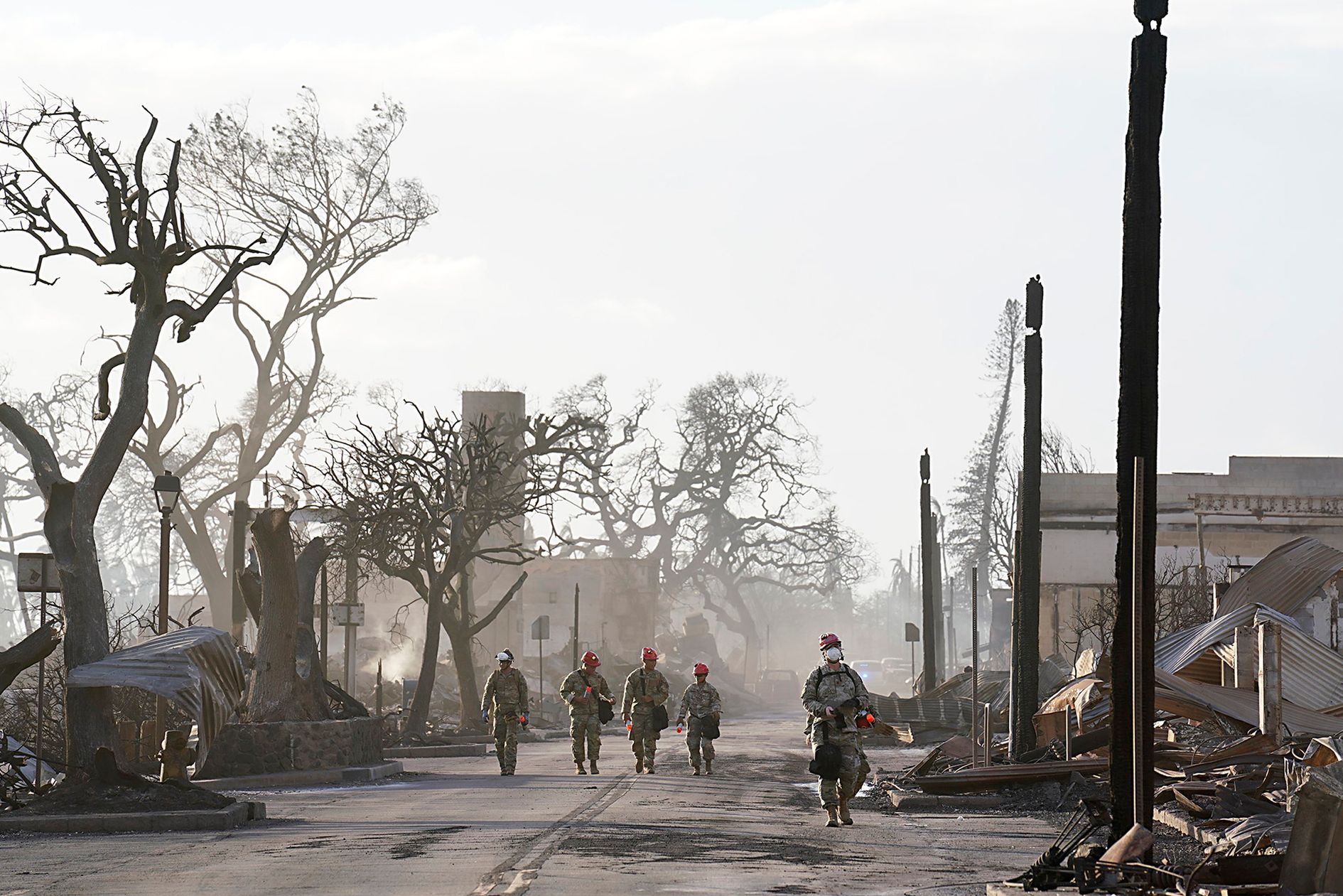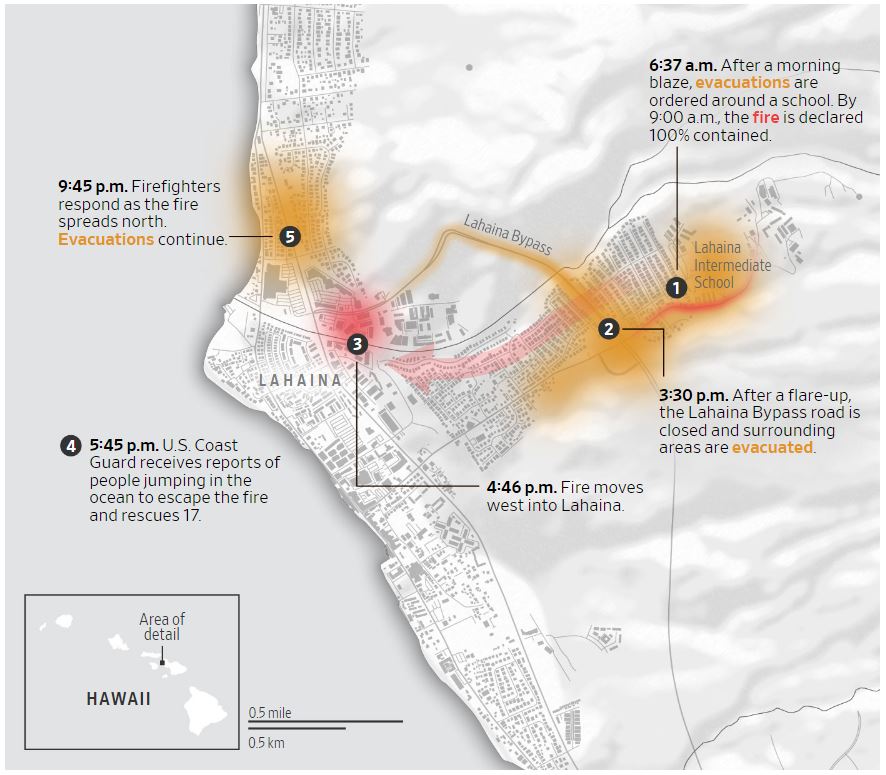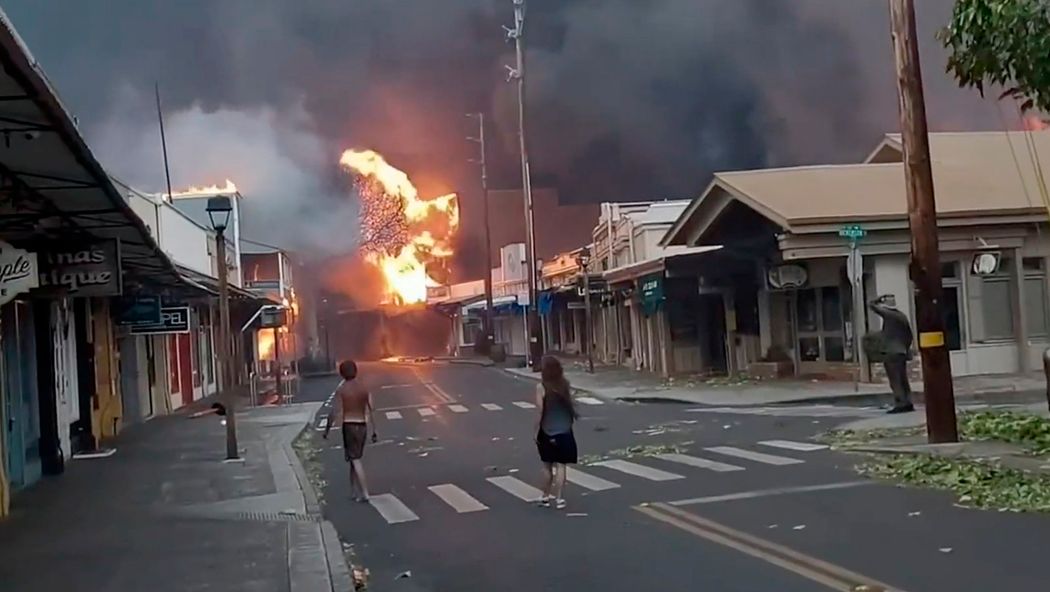Hawaii officials were warned years ago that Maui’s Lahaina faced High Wildfire Risk
Wall Street Journal 12th August 2023

Nearly a decade before a wildfire destroyed the coastal Maui town of Lahaina this week, killing at least 89 people, a report by Hawaiian fire researchers warned that the area was at extremely high risk of burning.
Another report, in 2020, tied fires to winds from a passing hurricane—similar to the ones that fanned the Lahaina blaze.
And the state’s electric utility had for years worried about wildfire risk in the area. It even flew drones to monitor conditions.
Yet local authorities said in the aftermath of this week’s devastation that though they knew wildfires were becoming more frequent in Hawaii, they weren’t prepared for one to roar through Lahaina.

The fire hit the coastal town so quickly and caught officials so off-guard that emergency sirens didn’t sound. Many panicked residents were unable to flee on the town’s one clogged highway and took boats or swam to safety, if they were able to escape at all.
In 2014, a wildfire-protection plan for the area was written by the Hawaii Wildfire Management Organization, a non-profit that works with government agencies. It warned that Lahaina was among Maui’s most fire-prone areas because of its proximity to parched grasslands, steep terrain and frequent winds.
The plan, which involved Maui and state officials, laid out a multitude of mitigation measures that needed to be undertaken to shield the area around Lahaina from fires. They included thinning vegetation near populated areas, improving wildfire-response capabilities and working with landowners and utilities to help reduce fire risk on their property.
Some of the recommendations from the 2014 plan, which was devised after more than a half-dozen community meetings, were implemented, like brush thinning efforts and public education for landowners, said the report’s lead author, Elizabeth Pickett. But others, such as ramping up emergency-response capacity, have been stymied by a lack of funding, logistical hurdles in rugged terrain and competing priorities, said Pickett, co-executive director of the wildfire non-profit.
“We’ve been hammering this home, and it’s just really frustrating and heart breaking to see that some things could have been done, but we couldn’t find money,” she said. “We are living through what happens when there’s a lag and everyone’s still catching up.”
Representatives for the Hawaii State and Maui county governments didn’t respond to requests for comment.
Asked at a press conference Thursday why the state wasn’t more prepared, Hawaii Gov. Josh Green said, “We’ve never experienced a wildfire that affected a city like this before.”
He said officials were particularly surprised that Hurricane Dora, which passed by Hawaii this week, caused winds as strong as 60 miles an hour (100 km/h) , driving the blaze into Lahaina faster than emergency responders and residents could keep up.
“This was, of course, a shock to see a hurricane and its winds and trade winds cause collateral damage, which was the spread of fire,” he said.
But that risk was known too.
The fire danger from passing hurricanes in Hawaii was documented in a 2020 report by researchers at the University of Hawaii and the East-West Center, which tied a 2018 outbreak of fires on both Maui and Oahu to winds from Hurricane Lane.
Like Hurricane Dora, Hurricane Lane passed the islands to the south, but sparked four fires—three on West Maui and one on Oahu—which blackened about 3,000 acres.
Over the past decade, an average of 20,000 acres have burned annually in Hawaii, more than quadruple the pace from a century ago, according to the Pacific Fire Exchange, a wildfire research group.
One of the main causes has been the proliferation of non-native grass and shrubs, the group said.
The researchers in the 2020 hurricane report said the fires tied to Lane ignited in areas dominated by non-native grasses, which are exceptionally flammable and have proliferated in recent years, now covering one-quarter of the state.
Non-native grasses blanketed the sloped terrain around Lahaina.
Utility Lines
Jennifer Potter, a former state public utility commissioner who lives on Maui, said she began hearing growing concern from community members about fire activity on the island beginning in 2019. That same year, Hawaiian Electric, the state’s main utility, said it would fly drones over areas including West Maui to identify utility lines prone to wildfires.
Documents show Hawaiian Electric submitted a request for funding in 2022 from the public utilities commission to help offset the $189.7 million it said it needed to bolster its power grid across the state, including wildfire-prevention measures. The request is still being processed.
A spokesman for the utility didn’t respond to requests for comment.
“There was absolutely knowledge within the state and within the electric industry that fire was a huge, huge concern on the island of Maui, and even more so than any of the other islands,” Potter said. “I don’t think it’s fair to say we’ve never seen this coming.”
Residents of Lahaina said they didn’t see the fire coming just hours before it reached their town Tuesday.
Around 9 a.m. local time that day, Maui officials said the wildfire outside Lahaina had been 100% contained. By midafternoon, however, it had grown out of control, driven by winds as strong as 60 miles an hour.
The Wildfire

“The fire that day moved so quickly, that from where it started in the brush to where it moved into the neighbourhood, communications back to those who make [emergency] notifications were physically nearly impossible,” he said.
Some Lahaina residents said they received emergency alerts, but many didn’t. The fire disabled cellular service in the city, as well as power and water.
Hawaii has what it says is one of the world’s largest siren systems to warn people of all kinds of events, including wildfires and hurricanes. Maui County has 80. State records don’t indicate that the sirens sounded in Lahaina, according to the Associated Press.
“Normally there’d be, like, a hurricane siren or something. None of that stuff went off,” said Kevin Campbell, who escaped Lahaina with his pregnant wife, Tasha.
When he tried to persuade friends to leave, he said, some argued that it was pointless for them to go. The single-lane Honoapi’ilani Highway, the main road out of town, was jammed with cars. Portions of it were closed because of downed power lines from the earlier windstorms.

Some residents and tourists abandoned their gridlocked cars on foot, while others rammed vehicles through gates, fled by boat, or waited out the fire in the ocean, witnesses said.
“It was so damn fast, by the time I realized, it was like a rainstorm of red sparks going sideways,” said Jo Ann Hayashi, who spent hours wading in the water of Lahaina Harbor to escape the flames.
Ginger Adams Otis, Suryatapa Bhattacharya and Christine Mai-Duc contributed to this article.
